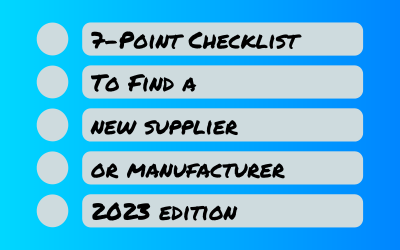Have you had a great idea for the perfect product, and want to turn it into a full-blown business? Getting the ball rolling can be the hardest step, especially if you plan to scale up your business and partner with vendors to launch your first product.
In this article we will provide you with the insight you need to get your idea from your head, to the shelves.
The First Step: Product Design
The design of a product directly determines whether consumers will purchase it. Nowadays, smart product design is important because consumers are more educated, informed, and powerful than ever before.
Before you start designing a product, you should first identify a market opportunity, and assess if there are any problems in the market that there are no good solutions for. This is also known as the “market gap”. Your product will perform best when it is developed as a proper solution for that problem.
Next, you can come up with a few ideas and eliminate those that are not feasible along the way. You will need to keep a few things in mind such as your target market, your budget as well as your own personal style. You will figure out how it is going to look, how it’s going to work, and what materials you’ll need to build it.
How to find the right manufacturer for your product
Once you have invented a new product, you need to find a manufacturer that can produce your product.
Finding the right manufacturer can be daunting. The easiest way is to use an online directory such as Zipfox to look for manufacturers and suppliers. Then, you can further shortlist potential manufacturers that specialize in the type of product you’ve designed.
Next, get these manufacturers to prepare a prototype. This can help you assess if the manufacturer can deliver your custom order. Also, a prototype allows you to see your product in person prior to getting a whole batch manufactured. Prototypes are a low-risk way to show proof of concept, and you can use it to receive constructive feedback.
How To Request Quotes And Compare Costs
When negotiating for a quotation, make sure that you outline all the details of the manufacturing process.
Here are some examples that are applicable when asking for quotes:
- Price: The price should be as low as possible, but still reasonable. Make sure this aligns with your budget and still leave some buffer room in case of other costs.
- Manufacturer’s Lead Times: Generally, the shorter the timelines, the better. It is best to avoid companies that take too long to deliver your products. Just in case you run out of stock and lose out on months of potential revenue.
- Shipping Costs: Shipping costs can quickly eat into your bottom line if left unchecked. Shipping costs are often calculated by volumetric weight, but it is best to check with your manufacturer.
- Minimum Order Quantity (MOQ): This refers to the minimum order size that the manufacturer is willing to accept. When you’re first starting out and unsure of the product demands, it is safer to lean with a smaller MOQ.
- Defect Policies: Defects can happen in manufacturing. And be sure to find out who pays for the costs of defective products.
- Production Processes: Depending on your product nature, the production may sometimes affect the quality of the product.
Quality Control And Manufacturing Standards
Now it’s finally time to start with the production! Be sure to detail as much as possible on your product specification sheet that you provide to your manufacturer. This should clearly define all specifications of the product and include things like the color, sizes, materials and components.
The product specification sheet is a great tool to reduce room for error and confusion. Many quality issues can be prevented by simply preparing a thorough product specification sheet!
Next, it is time to make sure that each product is up to standard. Quality control is integral in each step of product manufacturing. By sampling the product at different stages of production, you can identify if there is a production problem and prevent it in the future.
Delivering quality products to your customers will help you gain repeated business and contribute to the positive branding of your product.
Delivering Your Final Product
Congratulations on being one step closer to becoming an entrepreneur! Getting your products to market is a dynamic process where product inventors constantly evaluate ideas and consumer trends.
The most important thing is to remember not to get stuck in the pursuit of perfectionism, because it simply doesn’t exist in business. Even large companies such as Apple release a new and improved variation of a product every year. So, don’t be afraid to launch your first product, and start moving forward!











